Understanding Bird Plucking and Its Implications
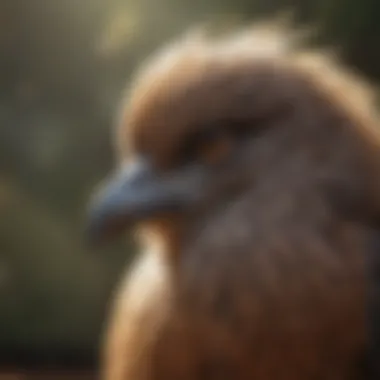
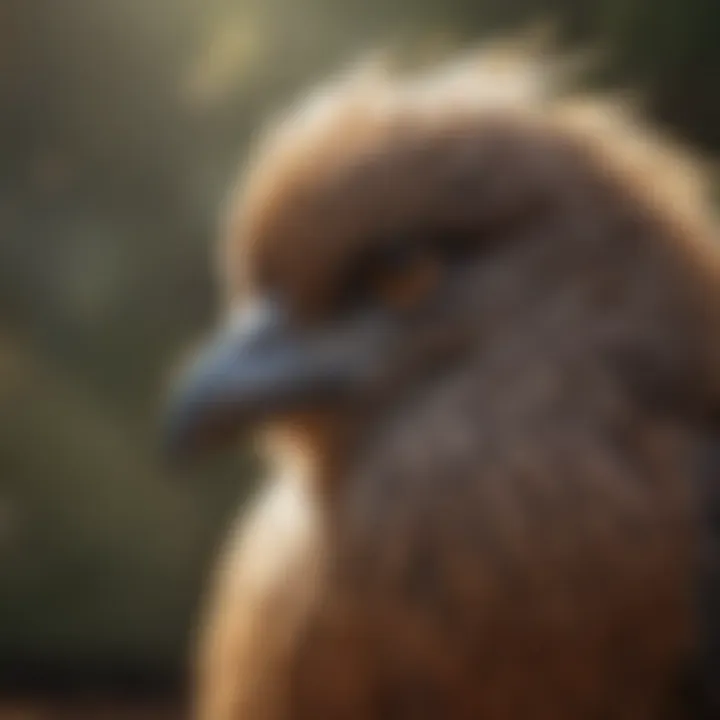
Intro
Bird plucking is a behavior that raises eyebrows among bird owners, pet enthusiasts, and ornithologists alike. It's not merely an odd quirk; it can signal deeper issues lurking beneath the feathers. Understanding this phenomenon requires a nuanced approach that considers both the emotional and physical states of our avian companions. You might have noticed your pet bird engaging in this behavior, and it felt like a slap in the face—something just doesn’t add up. So, what drives this affliction? In this article, we’ll explore the roots of bird plucking, how it resonates with the pet-owner experience, and what steps can be taken to mitigate, or even eliminate, this distressing habit.
Understanding Your Pet
Pet Behavior Basics
To comprehend bird plucking, it’s vital to first grasp the fundamentals of bird behavior. Birds are highly social creatures, and their actions often reflect their mood, environment, and overall welfare. When a bird plucks its feathers, it can be a physical manifestation of stress, boredom, or even loneliness. Observing your feathered friend closely can provide insight into what might be triggering such behaviors.
Common Breed Characteristics
Each bird species displays its own set of traits that can influence behavior. For instance, cockatoos are known for their affectionate temperament but can quickly become anxious if left alone too long. On the flip side, budgerigars tend to be more adaptable but require social engagement to keep them entertained and stimulated. Being aware of these characteristics can help owners forge effective coping strategies to address plucking.
Species-Specific Needs
Recognizing that each species has unique requirements is like knowing how to dance at a wedding; you need to know what moves to make. From environmental needs to social interaction, fulfilling these aspects crucially supports a bird's well-being. For example, African Grey parrots thrive on mental stimulation through puzzles and interactive toys, while canaries may appreciate a serene environment with plenty of perches.
Pet Care and Maintenance
Feeding Guidelines
What goes into your bird's beak matters immensely. A well-balanced diet is tantamount to their health. Fresh fruits, vegetables, and high-quality pellets should be staple items in their diet. Offering a variety of foods not only sustains them physically but can also combat boredom, one of the underlying causes of plucking.
Grooming Essentials
Regular grooming can play a pivotal role in keeping your bird happy. Keeping their feathers well-maintained and their beak trimmed can prevent discomfort that might lead to self-plucking. Owners should incorporate brushing and bathing into their routine, treating it as a bonding experience rather than a chore.
Hygiene Practices
The cleanliness of your bird's environment directly affects its mental and physical health. Dirty cages can lead to stress and illness. Cleaning their space a couple of times a week, along with replacing bedding materials, can work wonders in making your pet feel secure and cared for. A clean home is a happy home—for both birds and their owners.
Training and Development
Basic Commands and Skills
Establishing open communication can bridge the gap between you and your pet. Teaching them basic commands through positive reinforcement often yields fantastic results. Just as you'd teach a child how to speak, training a bird requires patience and consistency, and gets them engaged and attentive.
Behavioral Training Techniques
Behavioral issues often stem from frustration or lack of stimulation. Obedience training coupled with reward-based systems enhances your bird's quality of life and reduces misunderstandings that may lead to plucking behavior. Regular practice can keep your bird's mind agile and less prone to unhealthy habits.
Addressing Common Behavior Issues
If you notice signs of stress or erratic behavior, it's important to intervene early. Understanding triggers and eliminating negative stimuli can prevent the escalation to feather plucking. It’s akin to turning down a loud radio when you’re trying to concentrate—less chaos, more focus.
Health and Wellness
Routine Vet Check-ups
Regular veterinary appointments act as a safety net for your beloved bird. Many health issues can be caught before they become serious simply by ensuring routine check-ups. Your vet can offer tailored advice on maintaining your bird's well-being.
Vaccination Needs
Vaccinations are critical in safeguarding your feathered friend against several avian diseases. Just as one would not ignore a child’s vaccinations, the same level of care should apply to your pet bird. Staying informed about necessary vaccinations will give you peace of mind and your bird a fighting chance.
Recognizing Signs of Illness
Knowing what to watch for can tip you off when something's amiss. A sudden change in behavior, lethargy, or a drop in appetite can be red flags demanding immediate attention. A good pet owner knows their bird’s quirks and habits; when those begin to change, it’s time to take action.
Enrichment and Activities
Indoor vs. Outdoor Activities
Birds need stimulation, whether they're indoors or outdoors. Indoor activities can include puzzle toys, climbing structures, or even interactive playtime with their owners. For outdoor lovers, spending time in a safe aviary can expose them to the sights and sounds of nature—opportunities that spark their curiosity and creativity.
Interactive Toys and Games
Providing a variety of toys can satisfy your bird's need for mental engagement. Toys that encourage foraging or problem-solving can keep your pet occupied for hours. However, just like children, birds can become bored too, so rotate their toys regularly to keep things fresh and exciting.
Socialization Opportunities
To flourish, birds need social interaction, whether with humans or other birds. Ensuring they have time out of their cage and interacting with various people can drastically improve their mental state. Plan for playdates or let them mingle with other educated birds. Just like humans, socialization breeds happiness and stability.
"Bird plucking isn’t just a pretty pattern of feathers on the floor; it’s an outcry for attention and care. Understanding this can empower pet owners to take the reins of guidance."
By embracing these aspects of understanding and caring for your pet, you take promising strides towards ensuring their well-being and happiness, steering clear of the often troubling waters of feather plucking.
Defining Bird Plucking
Bird plucking is a behavior that raises concerns among pet owners and researchers alike. Taking the time to understand what this behavior encompasses is crucial for establishing appropriate care for our avian companions. Addressing bird plucking not only improves the well-being of these birds but also fosters a healthier relationship between the birds and their owners.
What Is Bird Plucking?
Bird plucking, often referred to as feather picking, is the act of a bird removing its own feathers systematically. This behavior can manifest in a variety of ways, from occasional preening to extensive feather loss, leaving the bird almost bare in some cases. More than just a cosmetic issue, feather plucking often signifies deeper problems that may require attention.
Understanding the nuances of this behavior is paramount. Birds often engage in plucking due to a combination of physiological and psychological factors. For instance, they might be responding to physical discomfort, stress, or even boredom. Those interested in bird care must recognize that plucking can lead to serious health concerns, such as skin infections or prolonged discomfort if left unaddressed.
Distinguishing Plucking from Molting
To properly address the issue of bird plucking, it’s essential to differentiate between normal molting and symptomatic plucking. While both involve the loss of feathers, their triggers and outcomes are remarkably different.
Molting is a natural process that most birds experience at certain times of the year. During this phase, birds shed old feathers to make way for new ones, typically resulting in scattered feathers found around the cage or living space. This seasonal shedding occurs regularly and is often marked by growing new feathers, a transition towards a healthier plumage.
On the contrary, plucking is a behavior that can be driven by stress, anxiety, or health issues. It is often more erratic and can result in bare patches on the bird's body. Physically, papering the area around the plucking site can signal further issues, as feather loss can lead to irritation and infections. Recognizing this distinction enables caretakers to intervene appropriately and seek medical assistance if plucking becomes a pronounced issue.
"Being able to tell the difference can make all the difference in your bird's health."
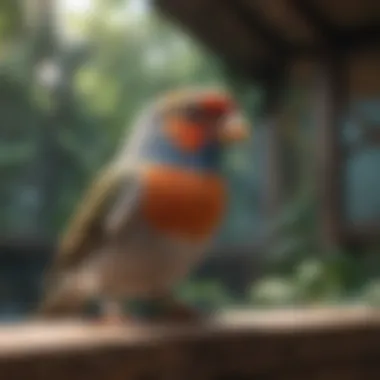
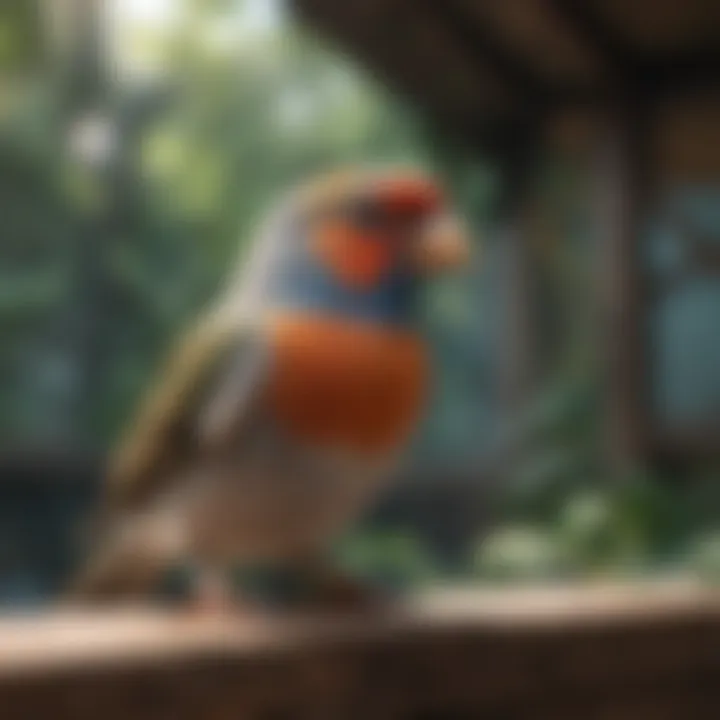
By understanding bird plucking in detail, owners can take proactive steps to improve their pets’ conditions, ensuring that they thrive in a loving, attentive environment.
The Causes of Bird Plucking
Understanding the causes of bird plucking is crucial as it acts as the first step in addressing the various physical and psychological issues that avian companions face. Comprehending these triggers allows pet owners to create an environment that prevents plucking, ensuring the birds maintain their natural behaviors and overall health. A careful analysis of both physical stressors and psychological triggers will provide valuable insights for effective interventions. Let's delve into the different factors that can lead to this concerning behavior.
Physical Stressors
Physical stressors refer to tangible conditions that can negatively affect a bird's well-being, leading to plucking behavior. This category includes several aspects, each having unique characteristics and implications.
Uncomfortable Living Conditions
Uncomfortable living conditions play a significant role in fostering stress among birds. This encompasses cramped cages, inadequate ventilation, or overly noisy environments. Inadequate space can limit a bird's natural movements, which is essential for a healthy lifestyle. Birds thrive when they can spread their wings, both literally and metaphorically.
- Key Characteristic: Birds need space for stretching, climbing, and exploring. A cage that feels cramped can increase feelings of confinement.
- Unique Feature: Proper cage dimensions tailored to the bird's species can directly influence its physical and mental state, making it an invaluable consideration for owners.
- Advantages vs. Disadvantages: While some owners may believe smaller cages save space, it can lead to detrimental outcomes, including increased anxiety resulting in plucking.
Nutritional Deficiencies
Nutritional deficiencies are another physiological factor that impacts the birds' propensity to pluck. Birds require a diverse diet rich in vitamins and minerals, and shortfalls in these nutrients can lead to health problems and poor feather quality.
- Key Characteristic: Essential nutrients like fatty acids, proteins, and vitamins directly affect feather health. When these are lacking, it can lead to discomfort.
- Unique Feature: A well-balanced diet not only boosts a bird's immunity but also enhances feather quality, positively influencing the bird's overall health.
- Advantages vs. Disadvantages: Providing only seeds or other limited diets may seem easy, but such habits can lead to severe health implications, including plucking.
Illness and Pain
Illness and pain can often trigger bird plucking behavior as a response to discomfort. Any undiagnosed medical issue may lead birds to self-soothe by plucking.
- Key Characteristic: Painful conditions, whether chronic or acute, often lead to behavioral changes indicating distress, including excessive feather removal.
- Unique Feature: Regular veterinary check-ups can help identify hidden health issues that may not be apparent initially.
- Advantages vs. Disadvantages: Not addressing health concerns can lead to a cycle where plucking becomes the only outlet for the bird's discomfort, leading to further health complications.
Psychological Triggers
Psychological triggers stem from emotional factors that can be just as impactful as physical stressors. Recognizing these elements is key to understanding bird behavior and helping alleviate plucking tendencies.
Anxiety and Fear
Anxiety and fear within a bird's environment can lead to severe behavioral manifestations, including plucking. Factors such as sudden loud noises, unfamiliar people, or animals can heighten these feelings.
- Key Characteristic: Birds are sensitive creatures; what might be a minor disturbance for humans can be a major source of anxiety for them.
- Unique Feature: Isolation or sudden changes in routine can exacerbate feelings of fear, leading birds to seek out comfort in destructive behaviors like plucking.
- Advantages vs. Disadvantages: Addressing anxiety requires not just observation but proactive measures to create a calming environment for the bird truly to thrive.
Loneliness and Boredom
Loneliness and boredom can lead birds to become withdrawn, pushing them towards destructive behaviors such as plucking. Birds are social beings, and inadequate interaction can lead to devastating consequences.
- Key Characteristic: Birds benefit significantly from companionship, whether it's with humans or other birds. Social interactions can keep their minds active and engaged.
- Unique Feature: Providing toys or scheduling playtime can greatly enhance a bird's quality of life, reducing the urge to self-destruct through plucking.
- Advantages vs. Disadvantages: While some owners may not realize the importance of socialization, neglecting this aspect can lead to more severe behaviors that may become difficult to correct.
Changes in Environment
Changes in environment can be a double-edged sword—it might be delightful to humans, but for many birds, it can evoke significant stress. Whether it's a new house, fresh paint, or even a new family member, these shifts can be overwhelming.
- Key Characteristic: Routine and familiarity offer comfort; sudden changes can unsettle even the most resilient of birds.
- Unique Feature: Gradual introductions to new environments can help birds adjust and mitigate the anxiety that change frequently brings.
- Advantages vs. Disadvantages: While moving to a new location may initially seem exciting, understanding the emotional toll on birds can help owners plan better and avoid unintentional triggers.
Recognizing both physical and psychological triggers is vital in mitigating bird plucking behavior. The interplay between an avian companion's health and living conditions can be the fine line between wellness and distress.
Understanding the Impact of Plucking
Bird plucking does not merely manifest as a physical issue; it resonates profoundly within a bird's overall well-being. These impacts create a cycle that can lead to a downward spiral, affecting not just the affected birds but also their owners' emotional states. Recognizing the consequences is essential for any bird owner who wishes to foster a healthy environment for their pets. This section provides an in-depth look at both the physical and psychological ramifications of this troubling behavior.
Physical Health Effects
Skin Infections
When a bird plucks its feathers, irritation and open skin can become a breeding ground for infections. Skin infections are not just a side effect; they can become a primary concern for owners. Birds often pluck due to discomfort or stress, and once the skin is raw, any bacteria can easily take hold.
The unique aspect of these infections is their potential to escalate quickly if not treated promptly. Skin infections can lead to scabs, inflammation, and even systemic health issues. Thus, recognizing the signs early becomes pivotal. If left unattended, these infections can hinder the bird's immune response and overall vitality, making it crucial for owners to monitor their birds closely.
Feather Regrowth Challenges
Another significant outcome of plucking is the feather regrowth challenges that follow. After a bird has plucked its feathers, growing them back is not a straightforward task. The follicles might get damaged during the plucking and can struggle to produce new feathers effectively. Main concern here is that feather regrowth is essential for a bird's insulation and flight ability.
This problem often leads to birds remaining partially or fully featherless for extended periods, which can aaffect their thermal regulation. This condition, coupled with a lack of proper protection from predators, puts birds at risk. In a nutshell, while feather regrowth might seem minor, it has profound implications for a bird's quality of life.
Psychological Consequences
Increased Stress Levels
Increased stress levels are a key aspect of the psychological consequences of bird plucking. Stress doesn't just occur in silence; it can be a loud and clear indicator of underlying issues. When a bird begins to pluck, it's often a cry for help, signaling that something in their environment is amiss. Elevated stress can lead to a myriad of health problems, including a weakened immune system and postural changes.
Feeding off anxiety, a bird may develop other undesirable behaviors. It's essential to understand the root cause of stress rather than just addressing the symptom of feather plucking. By focusing on alleviating these stressors, we may set the stage for a more tranquil existence for our feathered friends.
Behavioral Changes
Behavioral changes play a pivotal role in the broader context of bird plucking. A bird that regularly plucks is not just exhibiting a behavior; it’s often signaling emotional distress or dissatisfaction. Such behavioral shifts may include increased aggression, withdrawal, or changes in eating habits.
Typically, a formerly playful bird may sink into observing its environment with a noticeable detachment. The danger here is that these behavioral changes can become habitual if not proactively addressed by the owner. These can affect the bond between pets and their humans, creating a snowball effect on emotional health and trust.
"Understanding the impacts of bird plucking goes beyond feather loss. It touches upon the intricate details of emotional, physical, and relational dynamics within the owner-pet relationship."
By unraveling these complex layers, caregivers can equip themselves with the knowledge they need to help their birds thrive. Thus, ongoing commitment to a bird's environment and health is not just an option; it’s a necessity for a flourishing avian companion.
Prevention Strategies for Bird Plucking
Preventing bird plucking isn't just about managing a specific behavior; it relates deeply to the overall well-being and happiness of our feathered friends. Understanding how to mitigate the factors leading to this behavior is crucial. When pet owners take effective preventive measures, the chances of plucking can be significantly reduced, creating a more harmonious living environment. It’s like building a sturdy fortress where your birds feel both safe and entertained, ultimately leading to a vibrant, lively atmosphere.
Creating a Comfortable Habitat
Proper Cage Conditions
Providing proper cage conditions is foundational for a bird's health. A cage should not only be spacious, but it also should cater to the bird's specific needs. Birds like to spread their wings, so an oversized cage is often a beneficial choice.
Crucial characteristics include:

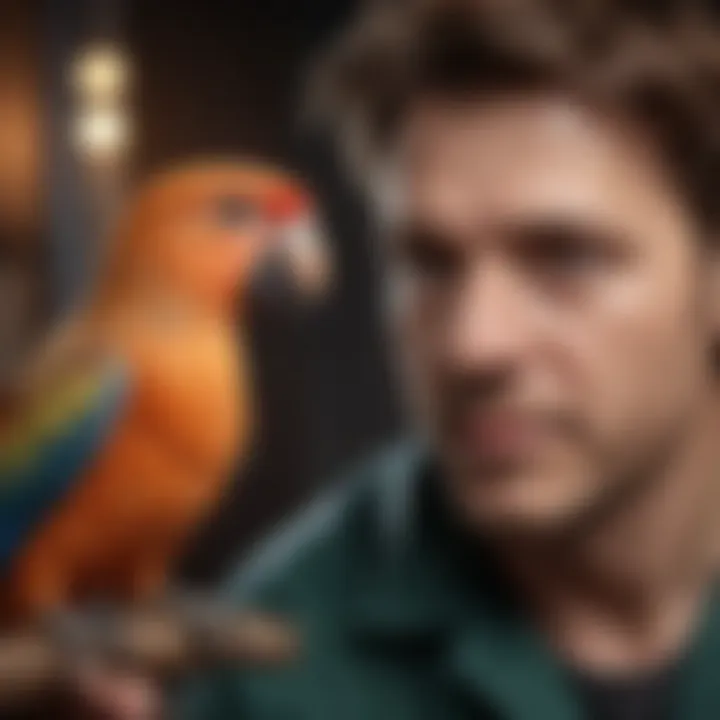
- Size: The cage must allow ample room for movement and perching. A larger habitat promotes mental stimulation and physical health.
- Safety: Use materials that are non-toxic and avoid plastic that can fall apart easily.
A unique aspect of proper cage conditions is the choice of bedding and toys. Suitable substrates can prevent foot injuries and keep the environment cleaner. While there are many options available, natural fiber bedding might be a wise choice. It is biodegradable and often more comfortable for the birds. The disadvantage of such options, though, can sometimes be cost, depending on preferences.
Environmental Enrichment
Environmental enrichment refers to ensuring that a bird’s surroundings are stimulating and engaging. This is not just about filling a cage with toys; it’s about encouraging natural behaviors. Adding various toys, perches of different textures, and even some climbing structures promotes exploration.
Key characteristics of environmental enrichment include:
- Variety: Rotating toys helps maintain interest and encourages problem-solving.
- Interactive Opportunities: Foraging toys can keep birds engaged, mimicking their natural instinct to search for food.
The unique feature of enrichment is its ability to help relieve boredom, which can be a significant trigger for plucking. However, introducing new toys too frequently might overwhelm some birds, so a balanced approach is essential.
Ensuring Nutritional Balance
Nutritional balance is a major part of preventing bird plucking. Just like humans, birds thrive on a balanced diet that meets their specific needs. A well-rounded diet provides not only physical health benefits but can also positively impact their emotional state.
Understanding Dietary Needs
Understanding a bird's dietary needs is vital. Different species have unique requirements, and knowing which fruits, vegetables, and seeds fulfill those needs is key. A basic aspect includes:
- Freshness: Always provide fresh food to avoid health issues related to spoiled items.
- Variety: Mixing foods ensures that birds can get essential nutrients, preventing deficiencies that might compel them to peck at their feathers.
The unique feature of understanding dietary needs is the ability to recognize the signs of poor nutrition early. For example, a bird losing feathers or showing lethargy can often trace back to diet issues. However, too many different foods at once can lead to digestive problems, so gradual introduction is essential.
Supplements and Vitamins
Supplements and vitamins can serve as a safety net for birds not getting enough from their food. They can help plug gaps in nutrition and support overall health.
Key aspects of supplements include:
- Targeted Nutrition: Different supplements can vary from calcium for strong bones to omega fatty acids for better feathers.
- Convenience: Pellets enriched with vitamins can simplify diet management.
But here’s the catch: some birds can be picky eaters. Introducing supplements might take time, and finding the right ones that suit your bird’s taste can sometimes be tricky. Furthermore, over-supplementation can lead to health problems, so it’s crucial to consult a vet before adding anything new.
"It's not just care; it's about understanding the full scope of what our birds need to thrive, both physically and emotionally."
In summary, focusing on creating comfortable habitats, ensuring nutritional balance, and being aware of your bird’s needs creates a nurturing environment. This can significantly reduce instances of plucking, allowing the birds to lead happier, healthier lives.
Intervention Techniques for Affected Birds
Intervention is crucial when dealing with bird plucking, as it addresses not only the immediate symptoms but also the underlying causes. Timely and effective intervention techniques can bring birds back to a healthier state, physically and mentally. In this section, we will explore various approaches that can help mitigate the effects of plucking, highlighting both behavior modification techniques and veterinary options.
Behavior Modification Approaches
Positive Reinforcement
Positive reinforcement is a cornerstone of effective behavior modification. By rewarding desirable behaviors, owners can encourage their birds to engage in healthier activities instead of plucking. The key characteristic of this method is its focus on rewards, rather than punishments. This creates a more encouraging environment where the bird feels secure and motivated to learn.
One unique feature of positive reinforcement is its adaptability. Owners can use treats, verbal praise, or even play as a reward. This not only helps in bridging the understanding between the owner and the bird, but it also offers a consistent way to shift behavior. The major advantage here is the potential for fostering a stronger bond between them, enhancing trust and reducing anxiety. However, over-reliance on treats may lead to weight issues if not monitored.
Redirecting Undesirable Behavior
Redirecting undesirable behavior is another effective tactic in managing bird plucking. Instead of simply trying to stop the plucking, the focus shifts to guiding the bird towards alternative actions. This technique allows owners to pinpoint specific situations that trigger the plucking, effectively replacing that behavior with something more productive.
The key characteristic of this approach is its proactive nature. By anticipating triggers and offering distractions, such as interactive toys or engaging activities, owners can successfully minimize plucking episodes. A unique feature of redirection is its emphasis on understanding the triggers behind the behavior, which can vary widely among different birds. The advantage lies in its ability to nurture an environment where the bird finds enjoyment and stimulation, reducing the urge to pluck. However, it requires patience and consistency, as behavioral changes can take time.
Veterinary Solutions
Medical Treatments
When behavior modification techniques are not enough, medical treatments may be necessary. These can address underlying health issues causing or exacerbating plucking. The key aspect of medical treatments is their targeted nature, often focusing on skin health or hormonal balances that could be contributing to the problem.
A significant characteristic of this approach is that it provides a more scientific remedy to the problem, rather than relying solely on behavioral observations. For instance, veterinarians may prescribe medications to treat skin infections or hormonal abnormalities. The unique advantage of medical treatments is their ability to rapidly address physical symptoms, allowing the bird to start feeling better quickly. Yet, there are drawbacks; medications can sometimes lead to side effects, and treatments should always be guided by a professional veterinarian to ensure appropriateness and safety.
Behavioral Therapy Options
Behavioral therapy options offer a more structured way to address the psychological aspects of bird plucking. These therapies may involve a variety of methods, including cognitive behavioral techniques that help birds gradually adjust their responses to stressors. A key characteristic of behavioral therapy is its focus on understanding the emotional needs of birds and offering tailored strategies for improvement.
These therapies provide a unique feature by allowing for comprehensive assessments of the bird's behavior, pinpointing specific triggers, and developing personalized treatment plans. A major advantage is that therapy can promote long-lasting change by addressing the root causes rather than just symptoms. However, one challenge is that access to qualified professionals can vary by location, sometimes making this option less accessible for some pet owners.
In summary, effective intervention techniques for affected birds involve both behavioral modifications and veterinary solutions. Owners must consider their bird's unique circumstances and be prepared to adapt their approach over time. A combination of understanding, patience, and appropriate action can significantly improve a bird's quality of life, helping to alleviate the compulsion to pluck.
The Role of Owners in Managing Bird Health
The relationship between birds and their owners plays a crucial part in their overall well-being. Understanding this relationship allows owners to devise effective methods in protecting their feathered companions from stresses that could lead to behaviors like plucking. When owners are attentive and proactive, they can create an environment that promotes physical health and psychological stability. This section explores different ways owners can engage with their birds, emphasizing the importance of both monitoring and building a solid relationship.
Active Monitoring of Behavior
Owners who actively observe and engage with their birds are better equipped to address potential health issues before they escalate. By being attuned to their partner's behavior, they stand a better chance of recognizing signs of distress or potential plucking. Here are two key practices:
Recognizing Early Signs
A critical aspect of addressing issues in bird health is catching early signs of distress or behavioral change. Early recognition can significantly reduce the risk of severe problems such as excessive plucking. The main characteristic that defines this practice is vigilance in observation. By paying attention to subtle shifts in behavior, owners can respond quickly to emerging concerns. For instance, if a bird suddenly starts spending more time alone or grooming obsessively, these may be warning flags.
Recognizing early signs is beneficial because it allows for timely intervention, such as adjusting the bird's environment or seeking veterinary advice. However, the unique challenge is that small changes might be hard to notice at first. Therefore, owners should develop a routine of checking in on their birds daily, ensuring they can differentiate between typical behaviors and those that signal trouble.
Documenting Changes
Keeping track of changes in behavior is another effective technique that complements early recognition. Documenting alterations helps owners see patterns over time, which might not be apparent in day-to-day observation. Owners can keep records in a journal, noting dates, behaviors, and any environmental alterations. This practice reinforces notable trends, allowing quick recognition of potential health problems down the line.
Documenting changes is a wise choice since it provides detailed insights that help in discussions with veterinarians or behaviorists. One downside, though, could be remembering to maintain this habit diligently. If neglected, this important tool may lose its effectiveness, making comprehensive monitoring challenging.
Building a Trusting Relationship
Creating a bond between bird and owner is irreplaceable in managing bird health. A strong relationship fosters a sense of safety, reducing anxieties that could lead to behaviors like plucking. Below are two pivotal methods to strengthen connections:
Interactive Playtime
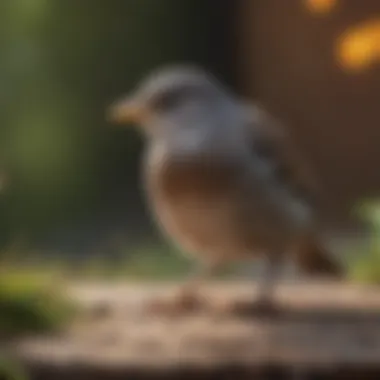
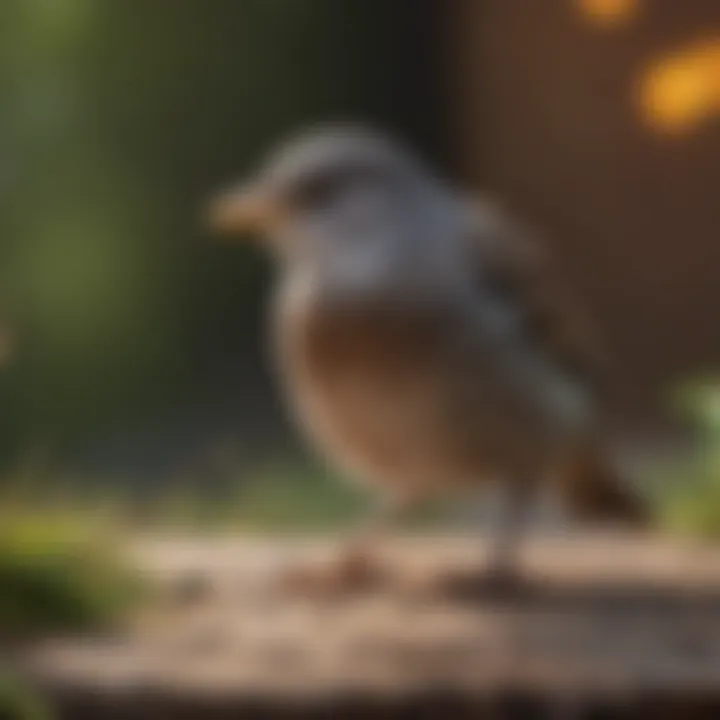
Engaging your bird in interactive play can significantly improve its emotional well-being. Regular playtime not only stimulates their body and mind but also assists in building trust. Interactive playtime can involve using toys, teaching tricks, or even simple games. This practice not only diverts their attention from potential stressors but also deepens the bond between the owner and the bird.
The unique feature of interactive playtime is that it encourages both physical exercise and mental engagement, both of which are crucial for a happy bird. However, caution should be exercised as not all birds respond positively to every form of play. Some may feel overwhelmed and require a gradual introduction to new games or toys.
Consistent Routines
Birds thrive on routine. Establishing consistent daily activities, such as feeding times, play periods, and quiet times, can offer birds a sense of security. An owner’s predictability helps reduce stress, making it easier for birds to relax and feel at home. The key characteristic of this routine is its regularity, fostering stability in an often unpredictable world.
While having a daily structure is advantageous as it gives birds something to rely on, the downside could be the difficulty of maintaining it due to life’s unpredictability. Some owners may find it challenging when unexpected events arise, disrupting the established schedule. Despite these challenges, making an effort to stick to routines as much as possible can yield significant benefits for birds and strengthen the human-animal bond.
In summary, a proactive and engaged approach by bird owners is invaluable in preventing issues like plucking. By monitoring behavior attentively and fostering trust through meaningful interaction, owners can create a nurturing environment that promotes bird health.
Exploring Bird Behavior in Context
Understanding bird behavior is an essential element in addressing issues like bird plucking. Birds, whether in the wild or as companions at home, are governed by complex social interactions and natural instincts that shape their actions. This section dives deep into these nuances, beneath the surface, shedding light on how companionship and innate behaviors play crucial roles in the well-being of our feathered friends. When we appreciate the context of their behavior, it paves the way for better care and intervention strategies.
Social Structures and Dynamics
The Importance of Companionship
Companionship among birds can’t be overstated. Many pet birds are flock animals, meaning they thrive on the socializing aspect of life. Having a partner or a friend can alleviate feelings of loneliness, serving as a buffer against stress and anxiety. In a well-adjusted environment, the presence of another bird provides comfort, allowing for a more stable emotional state.
One key characteristic of companionship is the bonding behaviors, which include preening each other and communicating through chirps and body language. This not only plays a part in strengthening the relationship but also reinforces the natural instinct of social interaction. For those looking to understand bird plucking, recognizing how companionship factors into overall happiness is vital.
However, it’s also crucial to keep in mind that introducing a new companion should be done thoughtfully. An abrupt change can sometimes lead to stress if birds do not bond well, creating complications instead of benefits.
Impact of Isolation
On the flip side, isolation is a significant contributing factor to behavioral issues, including plucking. Birds kept alone may face heightened stress levels due to loneliness. Isolation can result in drastic emotional consequences; for instance, a parakeet that typically chirps cheerfully may fall silent when left without social contact for an extended period.
A key characteristic of isolation is the behavioral changes that often manifest in plucking or excessive vocalizations. Owners must recognize that their pet's emotional and mental health hinges, in large part, on connection. While keeping a solitary bird is not inherently flawed, suitable interactions are indispensable.
The unique feature of a bird's need for companionship is highlighted in studies showing that solitary birds exhibit significantly higher levels of anxiety-related behaviors. This serves as a reminder to owners to facilitate social interactions, whether through companion birds or regular interactive playtime.
Natural Instincts and Adaptations
Preening Behaviors
Preening, a seemingly straightforward activity, offers considerable insight into bird welfare. It's not just about keeping their feathers tidy; it's also a social bonding mechanism and a way to maintain health. Preening serves the essential purpose of removing parasites and dirt, which directly relates to the overall health of the bird.
The key characteristic of preening behaviors is their dual role in both hygiene and socialization. When birds preen together, it strengthens their bond and reinforces their social structure. This multi-faceted nature of preening makes it an invaluable aspect to consider in any discussion about bird care and behavior.
Moreover, if a bird is not engaging in preening, it may be a signal of distress or illness, pushing for intervention. Observing these natural instincts allows owners to create an environment that fosters their well-being rather than hindering it.
Survival Mechanisms
Another aspect linked to bird behavior is the concept of survival mechanisms. These instincts—ingrained over millennia—help birds adapt and respond to environmental pressures. For instance, in wild settings, survival can hinge on quick reactions to threats; lack of proper instincts may lead to adverse effects, like compulsive behaviors, including plucking.
The survival mechanisms are characterized by behaviors that include vigilance and flocking. These traits underline why many species find comfort in social groups, providing both protection and companionship. Understanding this can help owners create more conducive habitats that mimic natural settings and mitigate stressors from isolation or threats.
Ultimately, a comprehensive approach to compassion in caring for birds must include a deep understanding of their behavior. This, in turn, plays a crucial part in preventing issues like plucking, guiding owners in creating environments that enhance the quality of life for their feathered companions.
When to Seek Professional Help
Knowing when to seek professional help for bird plucking is crucial in ensuring your feathered companion’s well-being. Many bird owners may hesitate to consult a vet for behavior issues, thinking they can handle it on their own. However, it is essential to recognize that persistent problems, especially those linked with plucking, can indicate more serious underlying issues. In this section, we will explore the importance of prompt intervention, which can ultimately lead to better outcomes for both the birds and their owners.
Recognizing Severe Cases
When we talk about recognizing severe cases of bird plucking, we’re diving into a realm that requires keen observation and proactive measures. Not all instances of plucking are equally concerning, but some are glaring red flags that should prompt immediate action.
Persistent Plucking
Persistent plucking is a significant concern. It refers to birds who constantly pull at their feathers, often to the detriment of their health. This behavior can become a cycle that is hard to break. Typically, if the plucking continues despite attempts to manage the bird’s environment or psychological needs, it’s a clear indicator that something more serious is at play.
Such persistent behavior can lead to serious complications. For instance, when birds pluck their feathers, they may expose their skin, making it vulnerable to infections.
- Key Characteristic: The repetitive nature of the behavior.
- Benefit: Early recognition helps in timely intervention.
- Unique Feature: Unlike normal preening, persistent plucking often worsens over time and can even change the bird’s overall demeanor.
- Disadvantages: If ignored, it can lead to dire health consequences and complicate treatment options down the line.
Accompanying Health Issues
The link between plucking and health issues cannot be overstated. Birds may pluck feathers due to pain from underlying medical problems that might not be immediately visible to the owner. For instance, a feathered friend with intolerable skin irritation or chronic pain may resort to plucking as a coping mechanism.
- Key Characteristic: Health issues often present themselves alongside behavioral changes.
- Benefit: Addressing health issues early on can alleviate both the physical discomfort and the plucking behavior.
- Unique Feature: Identifying and treating these health issues can lead to a noticeable improvement in the bird’s overall mood and behavior.
- Disadvantages: Failing to recognize the health component can lead to prolonged suffering and inadequate remedies focused solely on the behavior itself.
Summarizing the Key Takeaways
In closing, it becomes clear that comprehending the intricacies surrounding bird plucking is no small feat. It is a multidimensional issue that entangles both physical and emotional factors, affecting the overall health and wellbeing of birds. This article has strived to shine a light on various aspects, from defining bird plucking to detailing its causes, impacts, and even preventive measures.
Understanding these key takeaways is imperative for anyone who has a feathered friend or is simply passionate about birds. By grasping the causes, whether they stem from environmental stressors or psychological triggers, owners can embark on the journey of prevention and intervention. Here are the essential elements to keep in mind:
- Monitoring Behavioral Changes: Keeping an eye on your bird's habits can prevent severe cases of plucking before they escalate.
- Creating an Enriching Environment: Birds thrive in interactive spaces that mimic their natural habitats, allowing for natural behaviors such as exploring and socializing.
- Nutritional Health: A well-balanced diet plays a crucial role in maintaining your bird’s physical and mental health, minimizing the chances of self-destructive behaviors.
"Prevention is better than cure," remains a relevant adage here. When owners take proactive steps by fostering a loving and engaging environment, many issues can be nipped in the bud.
Comprehensive Care and Attention
Comprehensive care and attention are the bedrock of fostering a healthy bird. This means going beyond the basics of feeding and cleaning. A successful relationship with your avian companion relies not only on physical care but also on mental stimulation and emotional connection. Understand this: birds are intelligent creatures, so neglecting their social and psychological needs can lead to troubling behaviors like plucking.
Engage in daily interaction, establish consistent routines, and provide varied activities to keep your feathered friend stimulated. This might include:
- Interactive toys that encourage problem-solving,
- Regular out-of-cage time for exploration,
- Vocalization and training exercises that foster communication and bonding.
Each action contributes to an enhanced quality of life, creating a harmonious rapport that diminishes the need for adverse behaviors.
Continuing Education about Bird Welfare
Education is an ever-evolving journey, especially when it pertains to animal care. For pet owners, understanding bird welfare should be a continuous endeavor. Whether through reading reputable sources, joining forums like Reddit, or engaging with communities on Facebook, there are numerous ways to stay informed.
Keeping abreast of the latest findings related to avian health, training techniques and environmental considerations ensures that owners provide the best for their pets.
Consider these strategies to boost your knowledge:
- Engage with bird care literature: Explore articles and books focused on avian husbandry.
- Participate in workshops or seminars: These platforms often provide valuable insights directly from experienced avian specialists.
- Follow credible online platforms: Websites like Britannica provide scientifically backed information.
By investing time in learning, you enhance not just your knowledge but the wellbeing of your bird. In turn, the bond you create only grows stronger.







